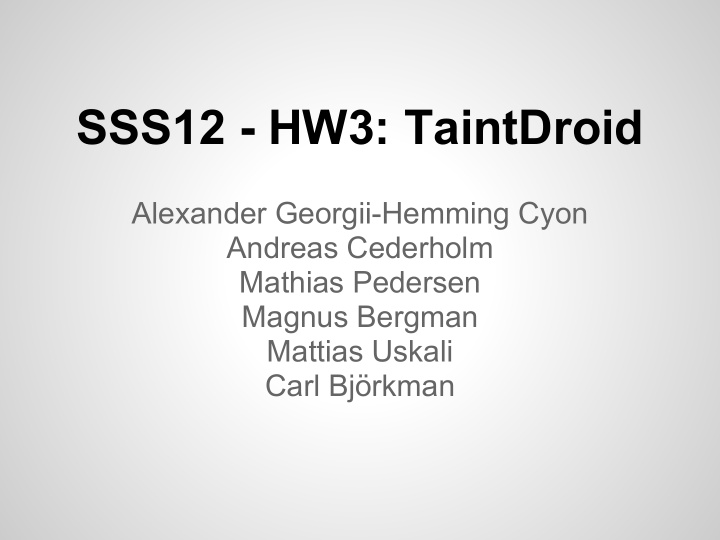



SSS12 - HW3: TaintDroid Alexander Georgii-Hemming Cyon Andreas Cederholm Mathias Pedersen Magnus Bergman Mattias Uskali Carl Björkman
Outline - What is TaintDroid? - Why TaintDroid? - Design challenges - Design of TaintDroid - Benchmarks and results - Limitations
Important note The authors of the paper are the creators of TaintDroid
What is TaintDroid? - TaintDroid is a software developed for Android with the purpose of analyzing Android applications with aspect to information flow (IF) - TaintDroid is an example of a dynamic analysis system of IF. - TaintDroid is developed by various academic persons in cooperation with Intel Labs. - The source code of TaintDroid is available at: www.appanalysis.org - TaintDroid modifies the Android OS
Why TaintDroid? - Applications on Android Market not verified by google( which is the case in AppStore) - Developers can only request coarse-grained permissions - Users rarely reads or understands the meaning of the permissions
How IF can be applied in mobile OS - It is possible to develop applications which exposes sensitive user information to third parties. - It is not only possible, there are a lot of apps which does so. - IF analysis helps with detecting those confidentially compromising apps.
Design challenges - Smartphones are resource constrained. Introducing CPU/RAM overhead is much noticeable on those devices. - Permission system is too coarse-grained, which gives third party apps access to a lot of sensitive user data. - Difficult to identify the sensitive data - Information can be leaked to other apps
TaintDroid taint sources - GPS - Files on SD-card - Contacts - Accelerometer - Microphone - Camera - SMS - Sim card data - IMEI Number
TaintDroid taint sinks - WiFi - 3G - Bluetooth - SMS - NFC
Level trackings
Flow of taints within TaintDroid
Flow of taints within TaintDroid ct'd - What Taintdroid does is - Every data read from a tainted source wich and store it in a variable than that variable will be tainted. - If that variable then is copied that variable will also be marked as tainted. - The taint tags are stored next to the variable in the memory in order to get good memory locality
Flow of taints within TaintDroid ct'd
Flow of taints within TaintDroid ct'd
Message-level tracking - Communication between applications - IPC uses parcels
Method-level tracking - Used for system-provided native libraries
File-level tracking - Ensures persistent information conservatively retains its taint markings
Benchmarks When benchmarking security they found out that out of 105 flagged instances, 37 of them turned out to be well-founded flags.
Benchmarks When it comes to speed there are two ways of measuring: "macroscopic" and "microscopic" speed benchmarking. Macroscopic: High-level functionality. "How long does it take to read a post in the contact list?" Microscopic: Automatable analysis of delays in low-level calls.
Benchmarks
Benchmarks Speed overhead in macroscopic analysis: App load time: 3% Address Book (create): 5% Address Book (read): 18% Phone Call: 10% Take Picture: 29%
Benchmarks Speed overhead in microscopic analysis: Java Microbench (CaffeineMark): 14% increase in score (more = bad)
Benchmarks Memory overhead in IPC throughput:
Benchmarks
Benchmarks
TaintDroid limitations - TaintDroid is incapable of detecting implicit IF - Only dynamic analysis, not static. - A lot of false positives - Only detecting, not preventing, leak of sensitive user information - Requires Android 2.1 - Modifies the Android OS
Recommend
More recommend